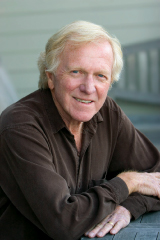In 1978, an NBC News special “I Want It All Now,” discussed among other things, how people in Marin soaked in hot tubs, enjoyed both white wine and white powder, and failed to discipline their children while tickling each other with peacock feathers.
Were these accurate depictions? Are we hedonistic? For years, I’ve searched throughout Marin for signs of Bacchus-like behavior. No luck. Rarely a hint. My conclusion: these aged perceptions are now absolutely not true. Yet this image has hounded the county for 30 years. A recent addition is that mostly wealthy and indifferent people live here. Regarding this latest perception, there could be some truth to it—but no more than in other upscale areas throughout the world.
So what is the essence of Marin?
A week ago, flying out of Oakland, I caught a glimpse of Marin from 22,000 feet. Shrouded in hills and pines and appearing just north of densely packed San Francisco, the county’s 520 square miles gave little clue that 258,000 people live here. That dichotomy alone—an almost hidden collection of cities and towns located within minutes of a world-class city—makes Marin a special place in today’s world. However, there’s more.
At that altitude, if by some miracle I could see Marin’s people, I would’ve found them for the most part to be caring and concerned and committed to making life better—both for themselves and for others. Scattered among Marin’s populace are artists like the 228 Marin Arts Council members who last month invited the entire county into their studios to critique and possibly purchase their creative efforts. That took guts. My view would have also included accomplished authors, not just Anne Lamott, Dave Eggers and Isabelle Allende, but also writers whose works took years to complete and were published to worldwide audiences. My point: There are an inordinate number of creative people living in Marin—including, most definitely, both active and retired entrepreneurs.
Speaking of business, if blessed with super-long-range vision, my glimpse after leaving Oakland would have spotted a dozen or so “Main Street” downtowns plus several up-to-date retail centers—yet nothing fancy or glitzy. In rural West Marin, communities haven’t changed much in the past half century. In the county’s populated areas, restaurants and cafes serve dishes from around the world and markets sell locally grown foods raised as they were decades ago—free of chemicals. And every day in Marin, an outdoor farmers market is occurring somewhere.
What I couldn’t have seen from high above—but know to be woven into Marin’s fabric of life—are Dominican University; COM; Marin Theatre Company; a fine K-12 school system; Marin Community Foundation; the Dipsea; the I.J.; 142 Throckmorton; the Rafael Film Center; wonderful libraries; the Marin Symphony; Book Passage; the Bolinas Museum; the Mill Valley Film Festival; Marin MOCA; the Marin Speakers Series; the Frank Lloyd Wright–designed Marin Civic Center; the Mountain Play; and the Marin County Fair.
Besides the prominence of Mount Tam, what I could clearly see after leaving Oakland were the Marin Headlands; Muir Woods; Point Reyes National Seashore; Tomales Bay; Samuel P. Taylor, Tamalpais and Angel Island state parks; nearly 100 miles of coastline and shoreline, half a dozen lakes and several open expanses, which hold incredible opportunities for hiking, biking, birding, sailing, surfing, tennis and golf.
And yes, for a few seconds I saw Highway 101 conveniently running up the county’s middle and those two prominent structures— one yellow, one white—San Quentin and the Buck Institute, which couldn’t be greater opposites, architecturally and culturally. What didn’t come into my view were Pickleweed Center, the county’s new Health and Wellness Campus, the Mill Valley Community Center, or any of the community clinics and facilities that offer a helping hand to Marin’s less fortunate. Nor did I see any evidence of SMART, the 70-mile eco-friendly commuter rail line, or Marin Clean Energy, the effort to make green power available countywide—as both are still in planning.
Stated as objectively as possible, the message here is that Marin, in 2009, is a very special place to live and work. Does it have its faults? Sure, several. However, over the years those negatives have received plenty of attention. Simply put, it’s time to recognize that Marin is like no other place in the world. That’s my point of view. What’s yours?
Email: [email protected]


